Comprehensive Report on Enterprise Risk Management for EasyJet Airline
VerifiedAdded on 2020/10/22
|20
|5126
|241
Report
AI Summary
This report provides a detailed analysis of EasyJet's enterprise risk management (ERM) practices. It begins with an introduction to EasyJet, its business model, and its objectives. The report then delves into EasyJet's risk management practices, including the identification of threats and opportunities, and the implementation of mitigation strategies. A key component of the report is the examination of EasyJet's risk register, which outlines potential risks, their likelihood, and impact. The report also discusses risk thresholds and the scoring approach used to assess risk levels. Furthermore, it covers the risk management process, including risk assessment programs, the development of relationships between operational risk and management actions, and the review process by the risk audit committee. The conclusion summarizes the key findings and emphasizes the importance of ERM in the airline industry. The report references various sources to support its analysis and recommendations.
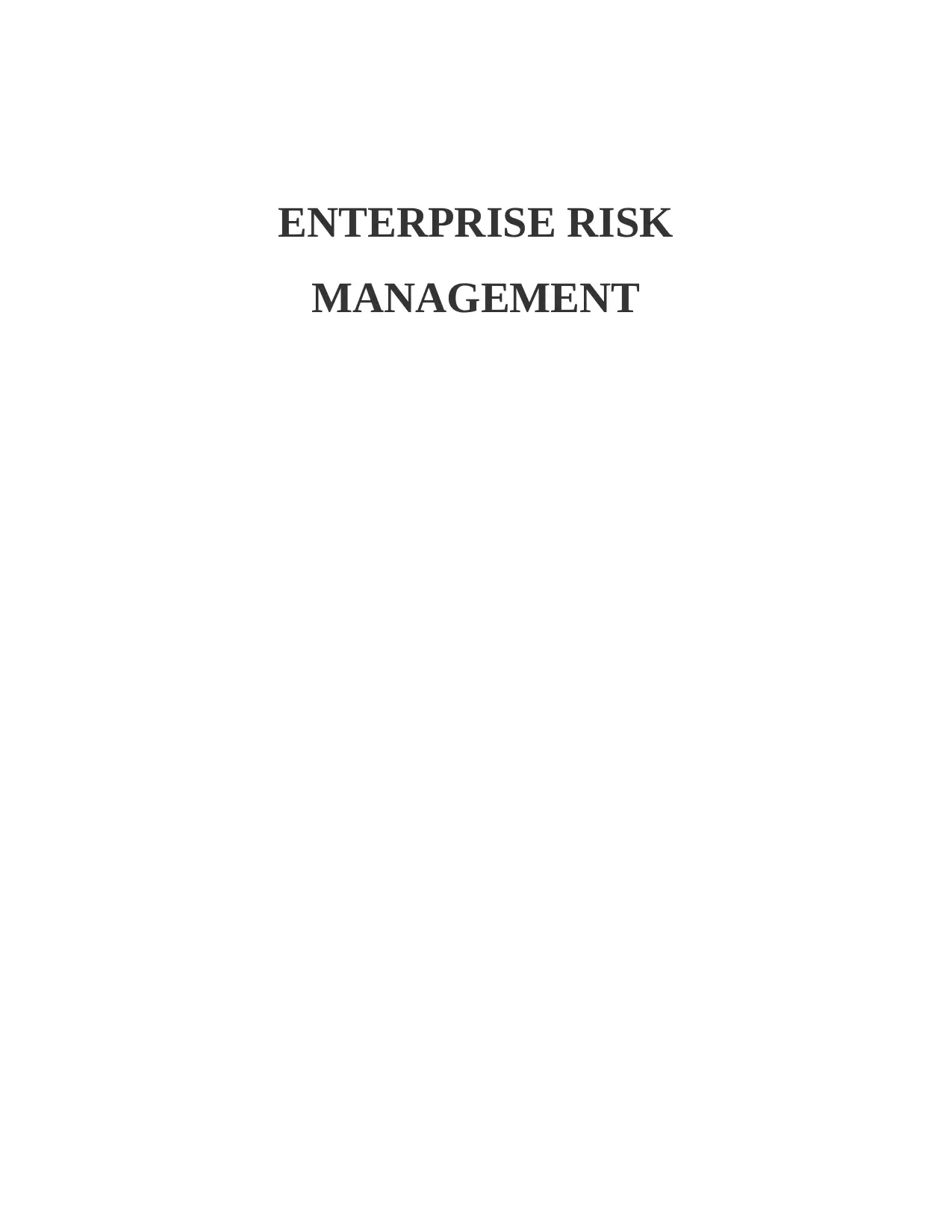
ENTERPRISE RISK
MANAGEMENT
MANAGEMENT
Paraphrase This Document
Need a fresh take? Get an instant paraphrase of this document with our AI Paraphraser
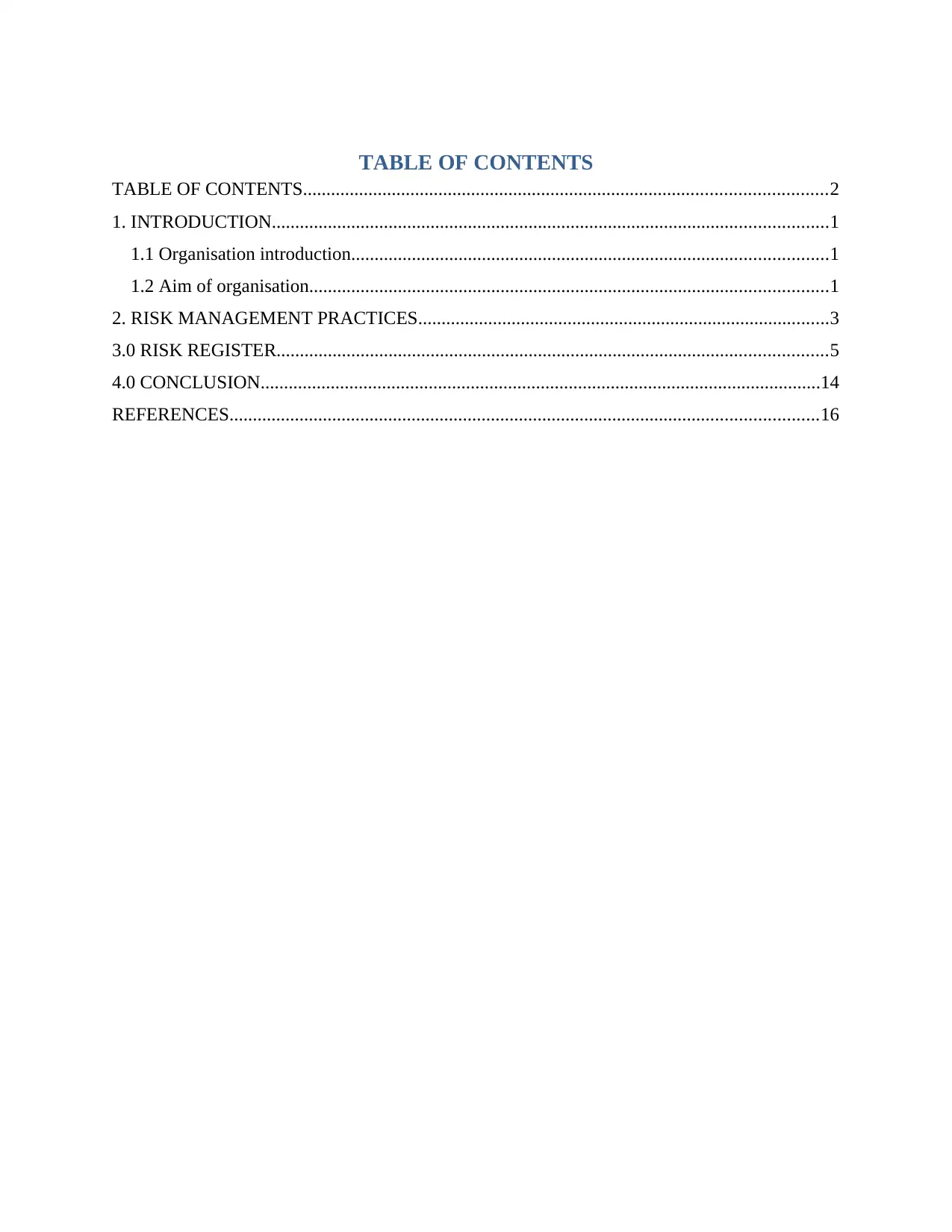
TABLE OF CONTENTS
TABLE OF CONTENTS................................................................................................................2
1. INTRODUCTION.......................................................................................................................1
1.1 Organisation introduction......................................................................................................1
1.2 Aim of organisation...............................................................................................................1
2. RISK MANAGEMENT PRACTICES........................................................................................3
3.0 RISK REGISTER......................................................................................................................5
4.0 CONCLUSION........................................................................................................................14
REFERENCES..............................................................................................................................16
TABLE OF CONTENTS................................................................................................................2
1. INTRODUCTION.......................................................................................................................1
1.1 Organisation introduction......................................................................................................1
1.2 Aim of organisation...............................................................................................................1
2. RISK MANAGEMENT PRACTICES........................................................................................3
3.0 RISK REGISTER......................................................................................................................5
4.0 CONCLUSION........................................................................................................................14
REFERENCES..............................................................................................................................16
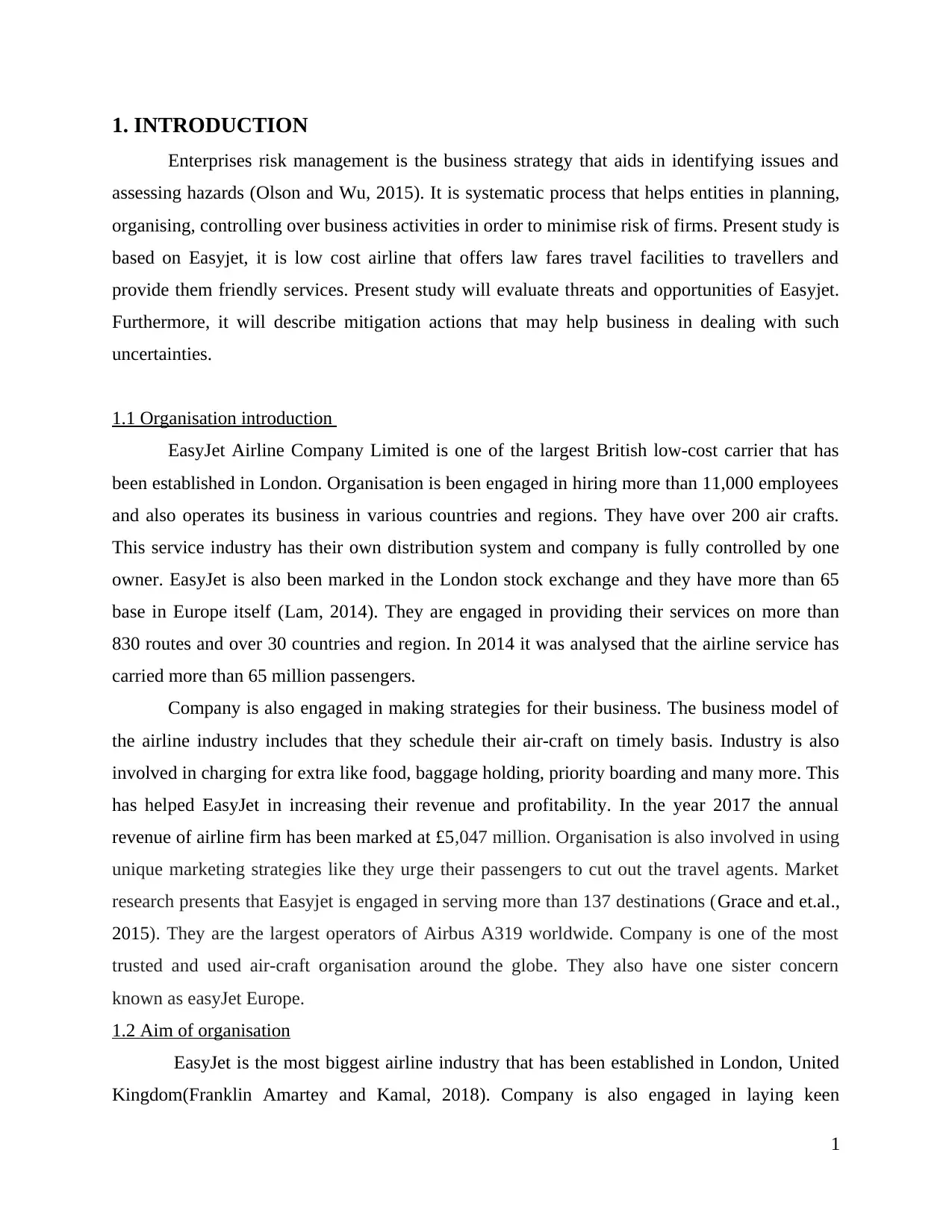
1. INTRODUCTION
Enterprises risk management is the business strategy that aids in identifying issues and
assessing hazards (Olson and Wu, 2015). It is systematic process that helps entities in planning,
organising, controlling over business activities in order to minimise risk of firms. Present study is
based on Easyjet, it is low cost airline that offers law fares travel facilities to travellers and
provide them friendly services. Present study will evaluate threats and opportunities of Easyjet.
Furthermore, it will describe mitigation actions that may help business in dealing with such
uncertainties.
1.1 Organisation introduction
EasyJet Airline Company Limited is one of the largest British low-cost carrier that has
been established in London. Organisation is been engaged in hiring more than 11,000 employees
and also operates its business in various countries and regions. They have over 200 air crafts.
This service industry has their own distribution system and company is fully controlled by one
owner. EasyJet is also been marked in the London stock exchange and they have more than 65
base in Europe itself (Lam, 2014). They are engaged in providing their services on more than
830 routes and over 30 countries and region. In 2014 it was analysed that the airline service has
carried more than 65 million passengers.
Company is also engaged in making strategies for their business. The business model of
the airline industry includes that they schedule their air-craft on timely basis. Industry is also
involved in charging for extra like food, baggage holding, priority boarding and many more. This
has helped EasyJet in increasing their revenue and profitability. In the year 2017 the annual
revenue of airline firm has been marked at £5,047 million. Organisation is also involved in using
unique marketing strategies like they urge their passengers to cut out the travel agents. Market
research presents that Easyjet is engaged in serving more than 137 destinations (Grace and et.al.,
2015). They are the largest operators of Airbus A319 worldwide. Company is one of the most
trusted and used air-craft organisation around the globe. They also have one sister concern
known as easyJet Europe.
1.2 Aim of organisation
EasyJet is the most biggest airline industry that has been established in London, United
Kingdom(Franklin Amartey and Kamal, 2018). Company is also engaged in laying keen
1
Enterprises risk management is the business strategy that aids in identifying issues and
assessing hazards (Olson and Wu, 2015). It is systematic process that helps entities in planning,
organising, controlling over business activities in order to minimise risk of firms. Present study is
based on Easyjet, it is low cost airline that offers law fares travel facilities to travellers and
provide them friendly services. Present study will evaluate threats and opportunities of Easyjet.
Furthermore, it will describe mitigation actions that may help business in dealing with such
uncertainties.
1.1 Organisation introduction
EasyJet Airline Company Limited is one of the largest British low-cost carrier that has
been established in London. Organisation is been engaged in hiring more than 11,000 employees
and also operates its business in various countries and regions. They have over 200 air crafts.
This service industry has their own distribution system and company is fully controlled by one
owner. EasyJet is also been marked in the London stock exchange and they have more than 65
base in Europe itself (Lam, 2014). They are engaged in providing their services on more than
830 routes and over 30 countries and region. In 2014 it was analysed that the airline service has
carried more than 65 million passengers.
Company is also engaged in making strategies for their business. The business model of
the airline industry includes that they schedule their air-craft on timely basis. Industry is also
involved in charging for extra like food, baggage holding, priority boarding and many more. This
has helped EasyJet in increasing their revenue and profitability. In the year 2017 the annual
revenue of airline firm has been marked at £5,047 million. Organisation is also involved in using
unique marketing strategies like they urge their passengers to cut out the travel agents. Market
research presents that Easyjet is engaged in serving more than 137 destinations (Grace and et.al.,
2015). They are the largest operators of Airbus A319 worldwide. Company is one of the most
trusted and used air-craft organisation around the globe. They also have one sister concern
known as easyJet Europe.
1.2 Aim of organisation
EasyJet is the most biggest airline industry that has been established in London, United
Kingdom(Franklin Amartey and Kamal, 2018). Company is also engaged in laying keen
1
⊘ This is a preview!⊘
Do you want full access?
Subscribe today to unlock all pages.

Trusted by 1+ million students worldwide
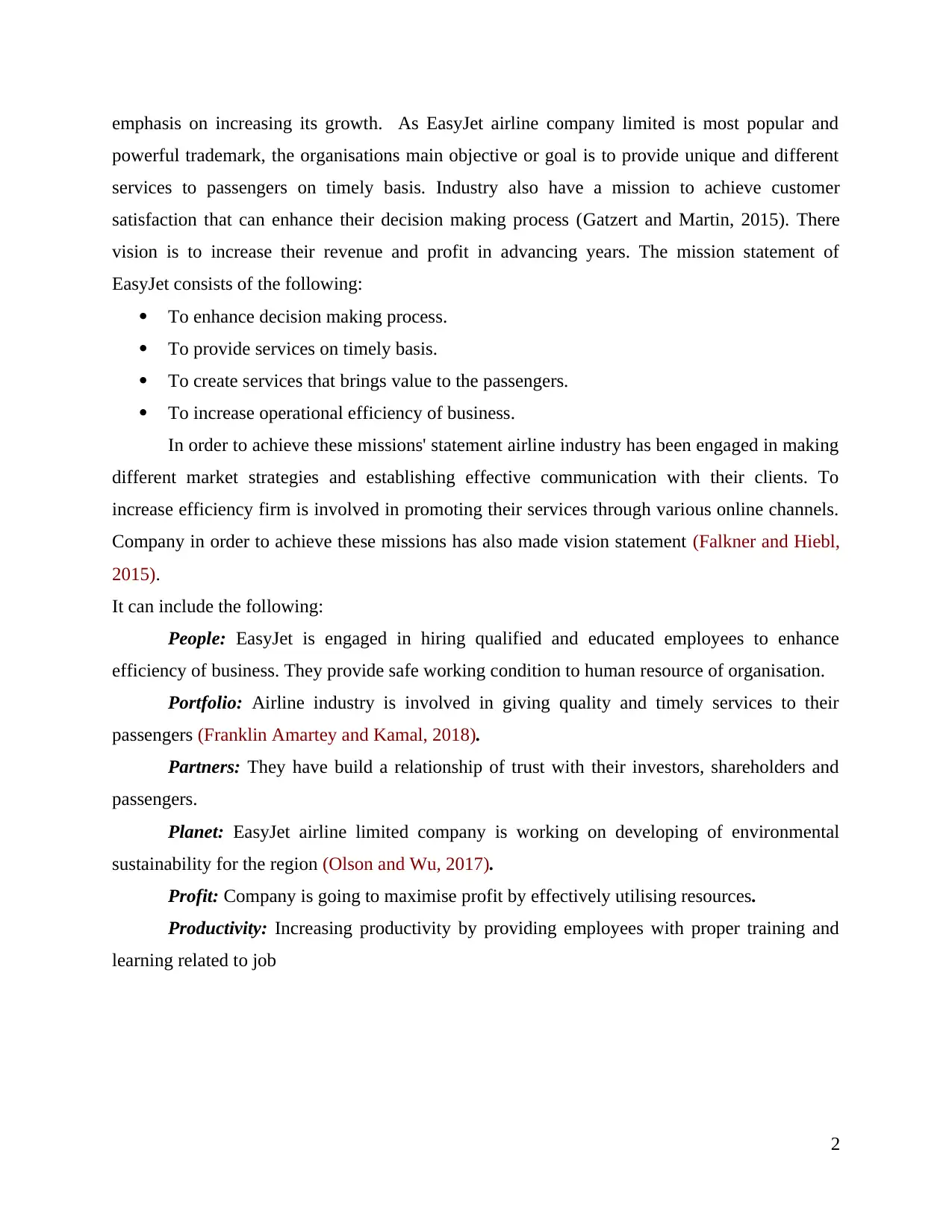
emphasis on increasing its growth. As EasyJet airline company limited is most popular and
powerful trademark, the organisations main objective or goal is to provide unique and different
services to passengers on timely basis. Industry also have a mission to achieve customer
satisfaction that can enhance their decision making process (Gatzert and Martin, 2015). There
vision is to increase their revenue and profit in advancing years. The mission statement of
EasyJet consists of the following:
To enhance decision making process.
To provide services on timely basis.
To create services that brings value to the passengers.
To increase operational efficiency of business.
In order to achieve these missions' statement airline industry has been engaged in making
different market strategies and establishing effective communication with their clients. To
increase efficiency firm is involved in promoting their services through various online channels.
Company in order to achieve these missions has also made vision statement (Falkner and Hiebl,
2015).
It can include the following:
People: EasyJet is engaged in hiring qualified and educated employees to enhance
efficiency of business. They provide safe working condition to human resource of organisation.
Portfolio: Airline industry is involved in giving quality and timely services to their
passengers (Franklin Amartey and Kamal, 2018).
Partners: They have build a relationship of trust with their investors, shareholders and
passengers.
Planet: EasyJet airline limited company is working on developing of environmental
sustainability for the region (Olson and Wu, 2017).
Profit: Company is going to maximise profit by effectively utilising resources.
Productivity: Increasing productivity by providing employees with proper training and
learning related to job
2
powerful trademark, the organisations main objective or goal is to provide unique and different
services to passengers on timely basis. Industry also have a mission to achieve customer
satisfaction that can enhance their decision making process (Gatzert and Martin, 2015). There
vision is to increase their revenue and profit in advancing years. The mission statement of
EasyJet consists of the following:
To enhance decision making process.
To provide services on timely basis.
To create services that brings value to the passengers.
To increase operational efficiency of business.
In order to achieve these missions' statement airline industry has been engaged in making
different market strategies and establishing effective communication with their clients. To
increase efficiency firm is involved in promoting their services through various online channels.
Company in order to achieve these missions has also made vision statement (Falkner and Hiebl,
2015).
It can include the following:
People: EasyJet is engaged in hiring qualified and educated employees to enhance
efficiency of business. They provide safe working condition to human resource of organisation.
Portfolio: Airline industry is involved in giving quality and timely services to their
passengers (Franklin Amartey and Kamal, 2018).
Partners: They have build a relationship of trust with their investors, shareholders and
passengers.
Planet: EasyJet airline limited company is working on developing of environmental
sustainability for the region (Olson and Wu, 2017).
Profit: Company is going to maximise profit by effectively utilising resources.
Productivity: Increasing productivity by providing employees with proper training and
learning related to job
2
Paraphrase This Document
Need a fresh take? Get an instant paraphrase of this document with our AI Paraphraser
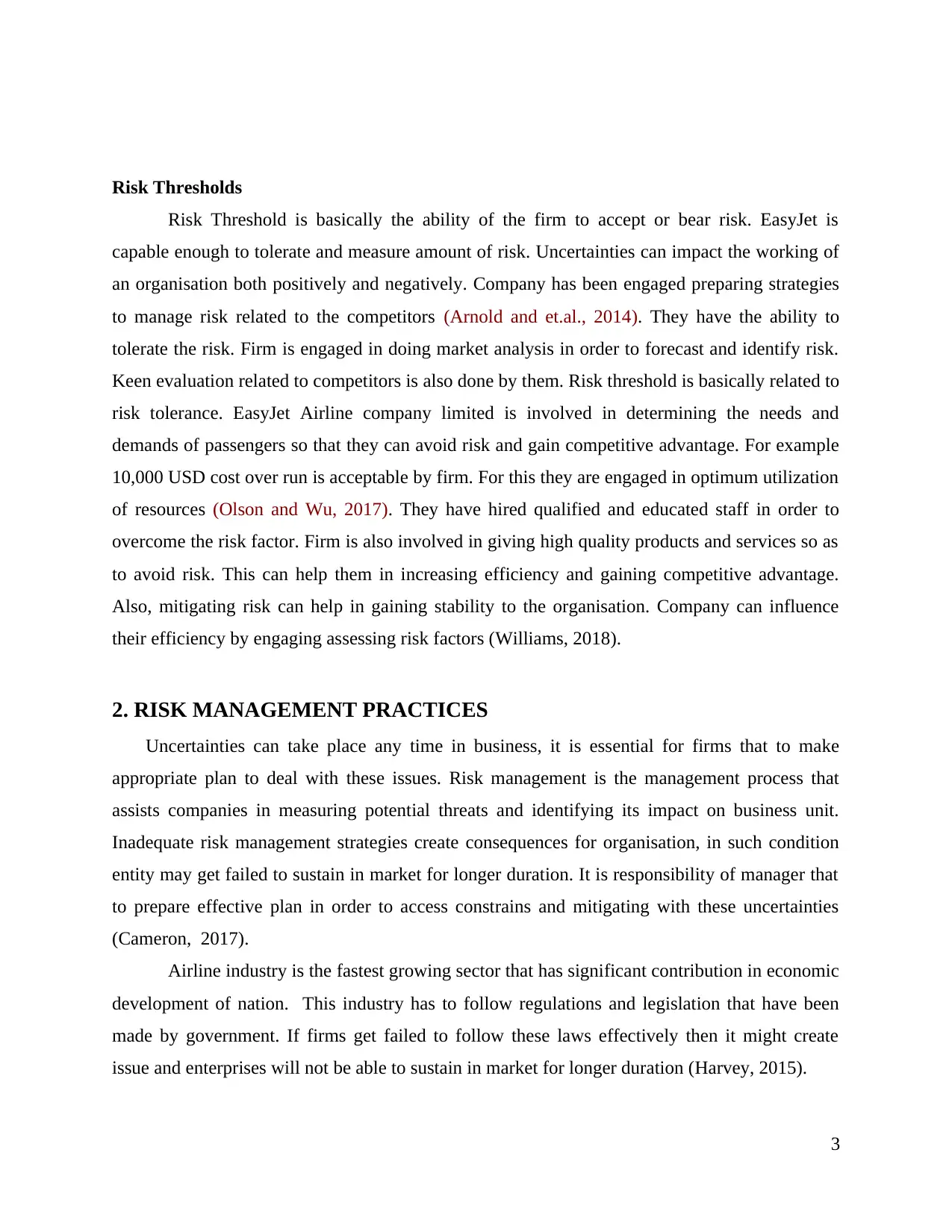
Risk Thresholds
Risk Threshold is basically the ability of the firm to accept or bear risk. EasyJet is
capable enough to tolerate and measure amount of risk. Uncertainties can impact the working of
an organisation both positively and negatively. Company has been engaged preparing strategies
to manage risk related to the competitors (Arnold and et.al., 2014). They have the ability to
tolerate the risk. Firm is engaged in doing market analysis in order to forecast and identify risk.
Keen evaluation related to competitors is also done by them. Risk threshold is basically related to
risk tolerance. EasyJet Airline company limited is involved in determining the needs and
demands of passengers so that they can avoid risk and gain competitive advantage. For example
10,000 USD cost over run is acceptable by firm. For this they are engaged in optimum utilization
of resources (Olson and Wu, 2017). They have hired qualified and educated staff in order to
overcome the risk factor. Firm is also involved in giving high quality products and services so as
to avoid risk. This can help them in increasing efficiency and gaining competitive advantage.
Also, mitigating risk can help in gaining stability to the organisation. Company can influence
their efficiency by engaging assessing risk factors (Williams, 2018).
2. RISK MANAGEMENT PRACTICES
Uncertainties can take place any time in business, it is essential for firms that to make
appropriate plan to deal with these issues. Risk management is the management process that
assists companies in measuring potential threats and identifying its impact on business unit.
Inadequate risk management strategies create consequences for organisation, in such condition
entity may get failed to sustain in market for longer duration. It is responsibility of manager that
to prepare effective plan in order to access constrains and mitigating with these uncertainties
(Cameron, 2017).
Airline industry is the fastest growing sector that has significant contribution in economic
development of nation. This industry has to follow regulations and legislation that have been
made by government. If firms get failed to follow these laws effectively then it might create
issue and enterprises will not be able to sustain in market for longer duration (Harvey, 2015).
3
Risk Threshold is basically the ability of the firm to accept or bear risk. EasyJet is
capable enough to tolerate and measure amount of risk. Uncertainties can impact the working of
an organisation both positively and negatively. Company has been engaged preparing strategies
to manage risk related to the competitors (Arnold and et.al., 2014). They have the ability to
tolerate the risk. Firm is engaged in doing market analysis in order to forecast and identify risk.
Keen evaluation related to competitors is also done by them. Risk threshold is basically related to
risk tolerance. EasyJet Airline company limited is involved in determining the needs and
demands of passengers so that they can avoid risk and gain competitive advantage. For example
10,000 USD cost over run is acceptable by firm. For this they are engaged in optimum utilization
of resources (Olson and Wu, 2017). They have hired qualified and educated staff in order to
overcome the risk factor. Firm is also involved in giving high quality products and services so as
to avoid risk. This can help them in increasing efficiency and gaining competitive advantage.
Also, mitigating risk can help in gaining stability to the organisation. Company can influence
their efficiency by engaging assessing risk factors (Williams, 2018).
2. RISK MANAGEMENT PRACTICES
Uncertainties can take place any time in business, it is essential for firms that to make
appropriate plan to deal with these issues. Risk management is the management process that
assists companies in measuring potential threats and identifying its impact on business unit.
Inadequate risk management strategies create consequences for organisation, in such condition
entity may get failed to sustain in market for longer duration. It is responsibility of manager that
to prepare effective plan in order to access constrains and mitigating with these uncertainties
(Cameron, 2017).
Airline industry is the fastest growing sector that has significant contribution in economic
development of nation. This industry has to follow regulations and legislation that have been
made by government. If firms get failed to follow these laws effectively then it might create
issue and enterprises will not be able to sustain in market for longer duration (Harvey, 2015).
3
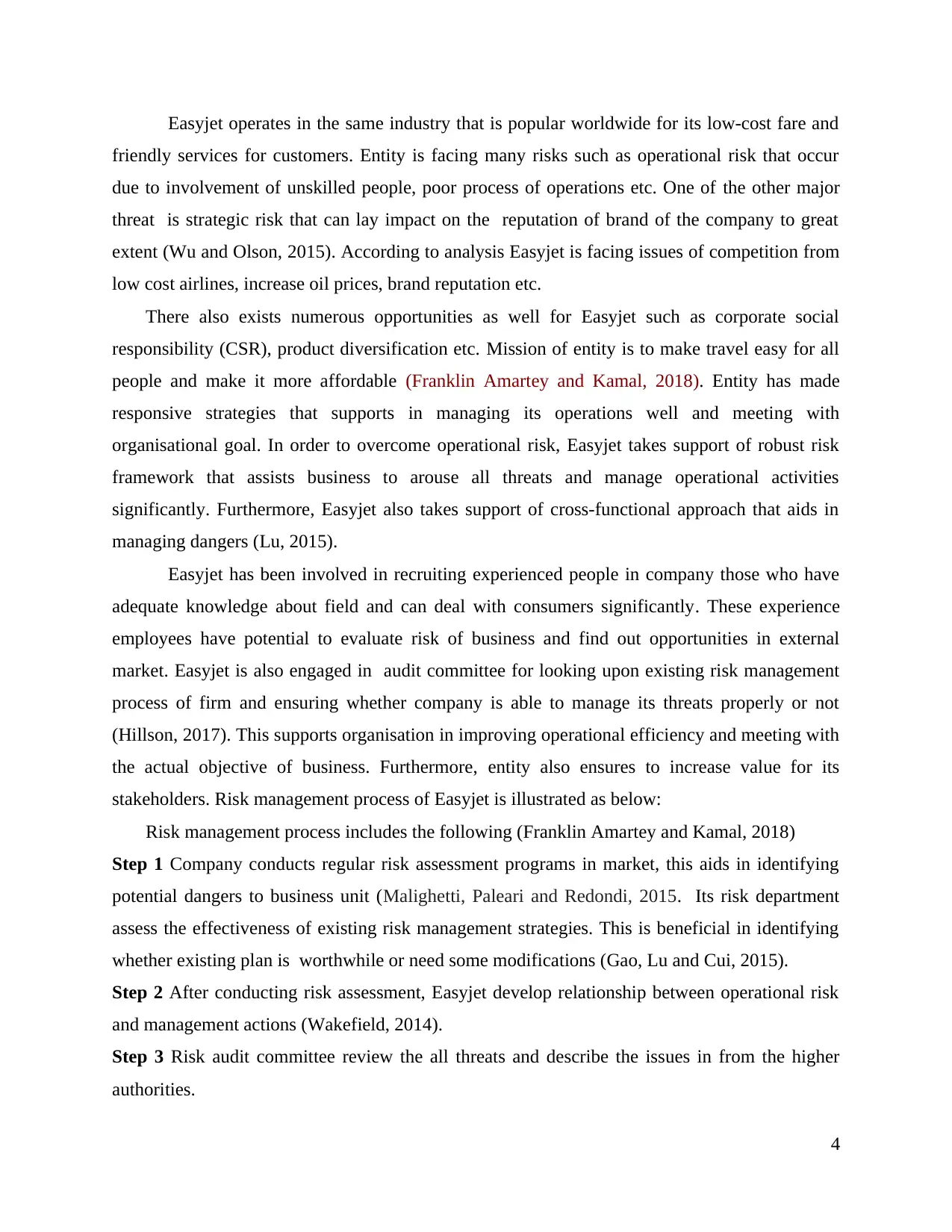
Easyjet operates in the same industry that is popular worldwide for its low-cost fare and
friendly services for customers. Entity is facing many risks such as operational risk that occur
due to involvement of unskilled people, poor process of operations etc. One of the other major
threat is strategic risk that can lay impact on the reputation of brand of the company to great
extent (Wu and Olson, 2015). According to analysis Easyjet is facing issues of competition from
low cost airlines, increase oil prices, brand reputation etc.
There also exists numerous opportunities as well for Easyjet such as corporate social
responsibility (CSR), product diversification etc. Mission of entity is to make travel easy for all
people and make it more affordable (Franklin Amartey and Kamal, 2018). Entity has made
responsive strategies that supports in managing its operations well and meeting with
organisational goal. In order to overcome operational risk, Easyjet takes support of robust risk
framework that assists business to arouse all threats and manage operational activities
significantly. Furthermore, Easyjet also takes support of cross-functional approach that aids in
managing dangers (Lu, 2015).
Easyjet has been involved in recruiting experienced people in company those who have
adequate knowledge about field and can deal with consumers significantly. These experience
employees have potential to evaluate risk of business and find out opportunities in external
market. Easyjet is also engaged in audit committee for looking upon existing risk management
process of firm and ensuring whether company is able to manage its threats properly or not
(Hillson, 2017). This supports organisation in improving operational efficiency and meeting with
the actual objective of business. Furthermore, entity also ensures to increase value for its
stakeholders. Risk management process of Easyjet is illustrated as below:
Risk management process includes the following (Franklin Amartey and Kamal, 2018)
Step 1 Company conducts regular risk assessment programs in market, this aids in identifying
potential dangers to business unit (Malighetti, Paleari and Redondi, 2015. Its risk department
assess the effectiveness of existing risk management strategies. This is beneficial in identifying
whether existing plan is worthwhile or need some modifications (Gao, Lu and Cui, 2015).
Step 2 After conducting risk assessment, Easyjet develop relationship between operational risk
and management actions (Wakefield, 2014).
Step 3 Risk audit committee review the all threats and describe the issues in from the higher
authorities.
4
friendly services for customers. Entity is facing many risks such as operational risk that occur
due to involvement of unskilled people, poor process of operations etc. One of the other major
threat is strategic risk that can lay impact on the reputation of brand of the company to great
extent (Wu and Olson, 2015). According to analysis Easyjet is facing issues of competition from
low cost airlines, increase oil prices, brand reputation etc.
There also exists numerous opportunities as well for Easyjet such as corporate social
responsibility (CSR), product diversification etc. Mission of entity is to make travel easy for all
people and make it more affordable (Franklin Amartey and Kamal, 2018). Entity has made
responsive strategies that supports in managing its operations well and meeting with
organisational goal. In order to overcome operational risk, Easyjet takes support of robust risk
framework that assists business to arouse all threats and manage operational activities
significantly. Furthermore, Easyjet also takes support of cross-functional approach that aids in
managing dangers (Lu, 2015).
Easyjet has been involved in recruiting experienced people in company those who have
adequate knowledge about field and can deal with consumers significantly. These experience
employees have potential to evaluate risk of business and find out opportunities in external
market. Easyjet is also engaged in audit committee for looking upon existing risk management
process of firm and ensuring whether company is able to manage its threats properly or not
(Hillson, 2017). This supports organisation in improving operational efficiency and meeting with
the actual objective of business. Furthermore, entity also ensures to increase value for its
stakeholders. Risk management process of Easyjet is illustrated as below:
Risk management process includes the following (Franklin Amartey and Kamal, 2018)
Step 1 Company conducts regular risk assessment programs in market, this aids in identifying
potential dangers to business unit (Malighetti, Paleari and Redondi, 2015. Its risk department
assess the effectiveness of existing risk management strategies. This is beneficial in identifying
whether existing plan is worthwhile or need some modifications (Gao, Lu and Cui, 2015).
Step 2 After conducting risk assessment, Easyjet develop relationship between operational risk
and management actions (Wakefield, 2014).
Step 3 Risk audit committee review the all threats and describe the issues in from the higher
authorities.
4
⊘ This is a preview!⊘
Do you want full access?
Subscribe today to unlock all pages.

Trusted by 1+ million students worldwide
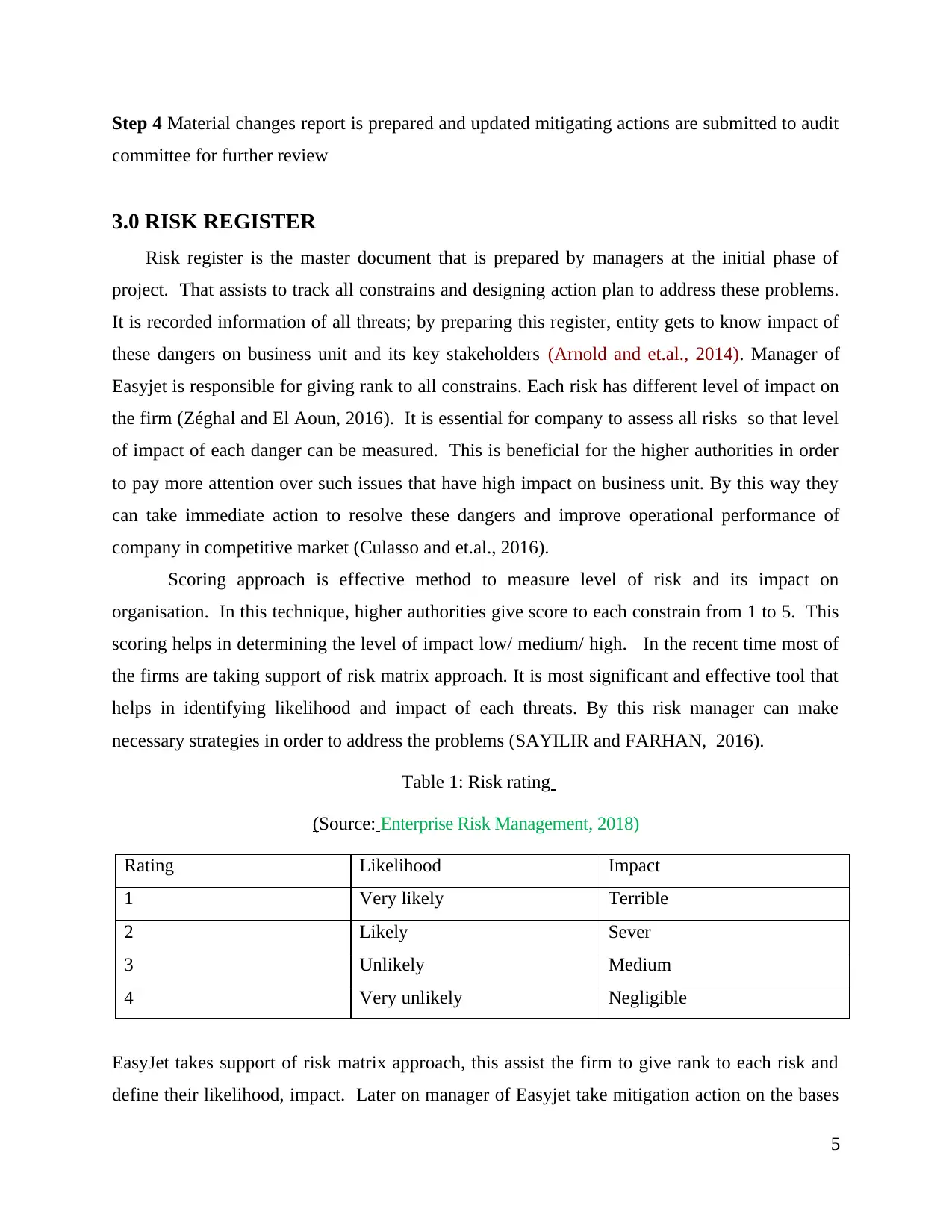
Step 4 Material changes report is prepared and updated mitigating actions are submitted to audit
committee for further review
3.0 RISK REGISTER
Risk register is the master document that is prepared by managers at the initial phase of
project. That assists to track all constrains and designing action plan to address these problems.
It is recorded information of all threats; by preparing this register, entity gets to know impact of
these dangers on business unit and its key stakeholders (Arnold and et.al., 2014). Manager of
Easyjet is responsible for giving rank to all constrains. Each risk has different level of impact on
the firm (Zéghal and El Aoun, 2016). It is essential for company to assess all risks so that level
of impact of each danger can be measured. This is beneficial for the higher authorities in order
to pay more attention over such issues that have high impact on business unit. By this way they
can take immediate action to resolve these dangers and improve operational performance of
company in competitive market (Culasso and et.al., 2016).
Scoring approach is effective method to measure level of risk and its impact on
organisation. In this technique, higher authorities give score to each constrain from 1 to 5. This
scoring helps in determining the level of impact low/ medium/ high. In the recent time most of
the firms are taking support of risk matrix approach. It is most significant and effective tool that
helps in identifying likelihood and impact of each threats. By this risk manager can make
necessary strategies in order to address the problems (SAYILIR and FARHAN, 2016).
Table 1: Risk rating
(Source: Enterprise Risk Management, 2018)
Rating Likelihood Impact
1 Very likely Terrible
2 Likely Sever
3 Unlikely Medium
4 Very unlikely Negligible
EasyJet takes support of risk matrix approach, this assist the firm to give rank to each risk and
define their likelihood, impact. Later on manager of Easyjet take mitigation action on the bases
5
committee for further review
3.0 RISK REGISTER
Risk register is the master document that is prepared by managers at the initial phase of
project. That assists to track all constrains and designing action plan to address these problems.
It is recorded information of all threats; by preparing this register, entity gets to know impact of
these dangers on business unit and its key stakeholders (Arnold and et.al., 2014). Manager of
Easyjet is responsible for giving rank to all constrains. Each risk has different level of impact on
the firm (Zéghal and El Aoun, 2016). It is essential for company to assess all risks so that level
of impact of each danger can be measured. This is beneficial for the higher authorities in order
to pay more attention over such issues that have high impact on business unit. By this way they
can take immediate action to resolve these dangers and improve operational performance of
company in competitive market (Culasso and et.al., 2016).
Scoring approach is effective method to measure level of risk and its impact on
organisation. In this technique, higher authorities give score to each constrain from 1 to 5. This
scoring helps in determining the level of impact low/ medium/ high. In the recent time most of
the firms are taking support of risk matrix approach. It is most significant and effective tool that
helps in identifying likelihood and impact of each threats. By this risk manager can make
necessary strategies in order to address the problems (SAYILIR and FARHAN, 2016).
Table 1: Risk rating
(Source: Enterprise Risk Management, 2018)
Rating Likelihood Impact
1 Very likely Terrible
2 Likely Sever
3 Unlikely Medium
4 Very unlikely Negligible
EasyJet takes support of risk matrix approach, this assist the firm to give rank to each risk and
define their likelihood, impact. Later on manager of Easyjet take mitigation action on the bases
5
Paraphrase This Document
Need a fresh take? Get an instant paraphrase of this document with our AI Paraphraser
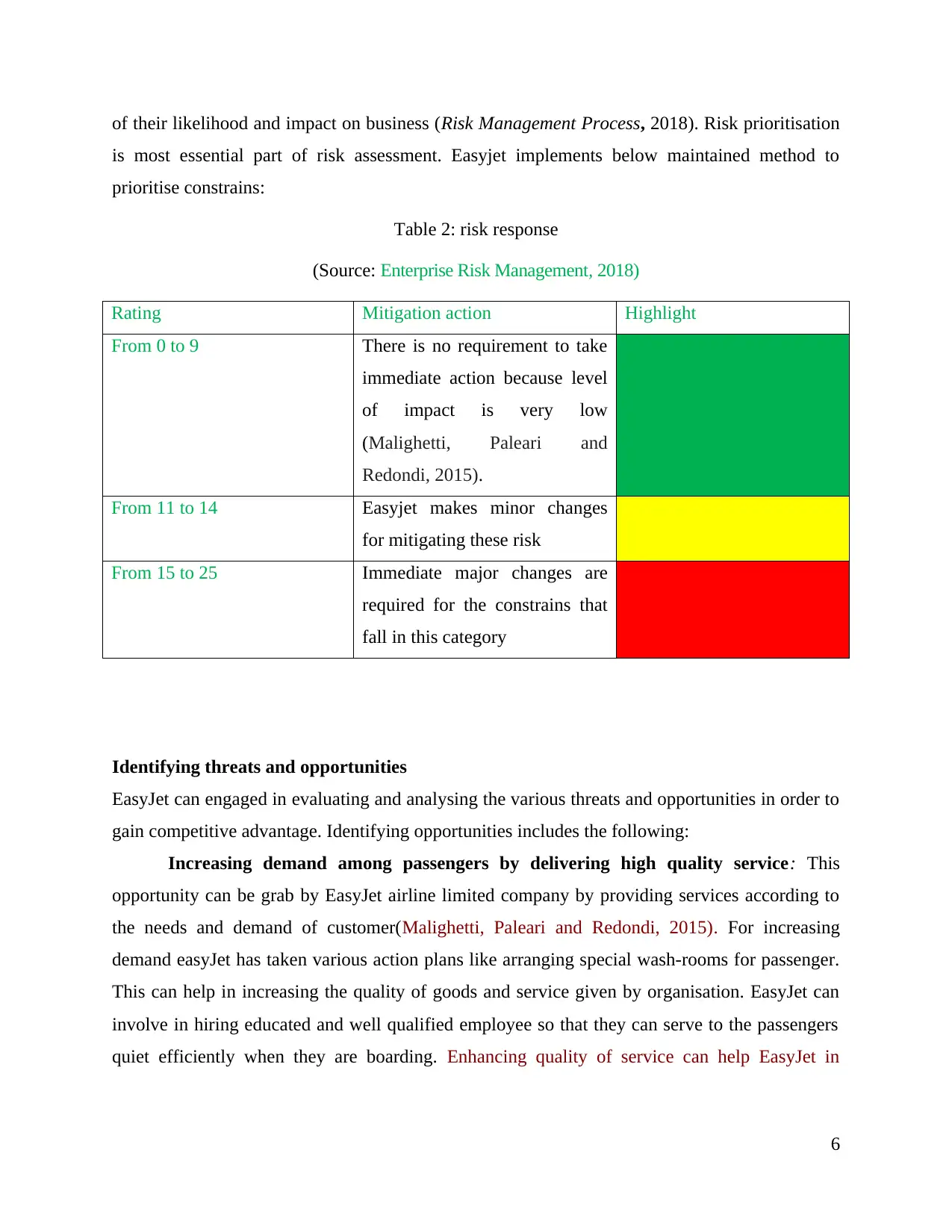
of their likelihood and impact on business (Risk Management Process, 2018). Risk prioritisation
is most essential part of risk assessment. Easyjet implements below maintained method to
prioritise constrains:
Table 2: risk response
(Source: Enterprise Risk Management, 2018)
Rating Mitigation action Highlight
From 0 to 9 There is no requirement to take
immediate action because level
of impact is very low
(Malighetti, Paleari and
Redondi, 2015).
From 11 to 14 Easyjet makes minor changes
for mitigating these risk
From 15 to 25 Immediate major changes are
required for the constrains that
fall in this category
Identifying threats and opportunities
EasyJet can engaged in evaluating and analysing the various threats and opportunities in order to
gain competitive advantage. Identifying opportunities includes the following:
Increasing demand among passengers by delivering high quality service: This
opportunity can be grab by EasyJet airline limited company by providing services according to
the needs and demand of customer(Malighetti, Paleari and Redondi, 2015). For increasing
demand easyJet has taken various action plans like arranging special wash-rooms for passenger.
This can help in increasing the quality of goods and service given by organisation. EasyJet can
involve in hiring educated and well qualified employee so that they can serve to the passengers
quiet efficiently when they are boarding. Enhancing quality of service can help EasyJet in
6
is most essential part of risk assessment. Easyjet implements below maintained method to
prioritise constrains:
Table 2: risk response
(Source: Enterprise Risk Management, 2018)
Rating Mitigation action Highlight
From 0 to 9 There is no requirement to take
immediate action because level
of impact is very low
(Malighetti, Paleari and
Redondi, 2015).
From 11 to 14 Easyjet makes minor changes
for mitigating these risk
From 15 to 25 Immediate major changes are
required for the constrains that
fall in this category
Identifying threats and opportunities
EasyJet can engaged in evaluating and analysing the various threats and opportunities in order to
gain competitive advantage. Identifying opportunities includes the following:
Increasing demand among passengers by delivering high quality service: This
opportunity can be grab by EasyJet airline limited company by providing services according to
the needs and demand of customer(Malighetti, Paleari and Redondi, 2015). For increasing
demand easyJet has taken various action plans like arranging special wash-rooms for passenger.
This can help in increasing the quality of goods and service given by organisation. EasyJet can
involve in hiring educated and well qualified employee so that they can serve to the passengers
quiet efficiently when they are boarding. Enhancing quality of service can help EasyJet in
6
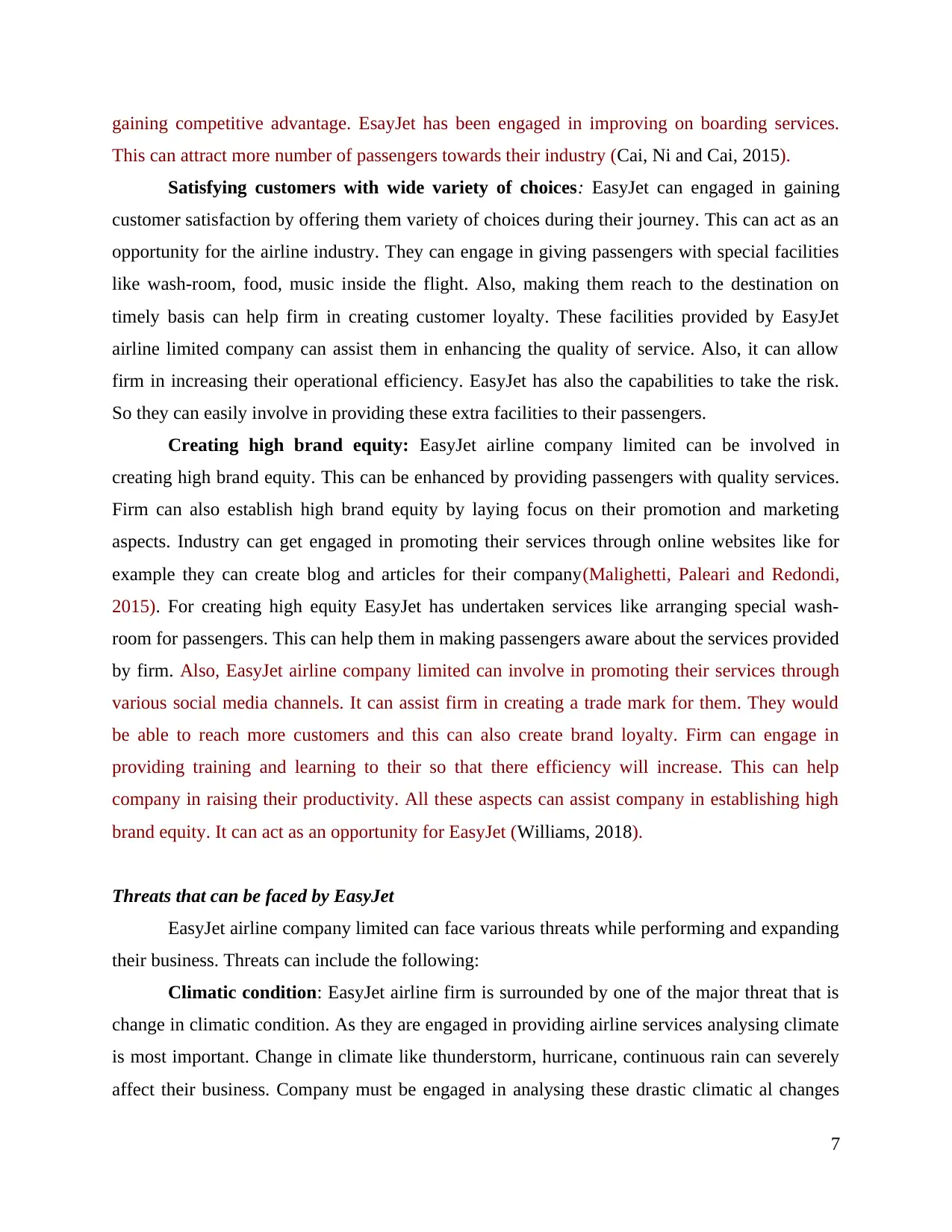
gaining competitive advantage. EsayJet has been engaged in improving on boarding services.
This can attract more number of passengers towards their industry (Cai, Ni and Cai, 2015).
Satisfying customers with wide variety of choices: EasyJet can engaged in gaining
customer satisfaction by offering them variety of choices during their journey. This can act as an
opportunity for the airline industry. They can engage in giving passengers with special facilities
like wash-room, food, music inside the flight. Also, making them reach to the destination on
timely basis can help firm in creating customer loyalty. These facilities provided by EasyJet
airline limited company can assist them in enhancing the quality of service. Also, it can allow
firm in increasing their operational efficiency. EasyJet has also the capabilities to take the risk.
So they can easily involve in providing these extra facilities to their passengers.
Creating high brand equity: EasyJet airline company limited can be involved in
creating high brand equity. This can be enhanced by providing passengers with quality services.
Firm can also establish high brand equity by laying focus on their promotion and marketing
aspects. Industry can get engaged in promoting their services through online websites like for
example they can create blog and articles for their company(Malighetti, Paleari and Redondi,
2015). For creating high equity EasyJet has undertaken services like arranging special wash-
room for passengers. This can help them in making passengers aware about the services provided
by firm. Also, EasyJet airline company limited can involve in promoting their services through
various social media channels. It can assist firm in creating a trade mark for them. They would
be able to reach more customers and this can also create brand loyalty. Firm can engage in
providing training and learning to their so that there efficiency will increase. This can help
company in raising their productivity. All these aspects can assist company in establishing high
brand equity. It can act as an opportunity for EasyJet (Williams, 2018).
Threats that can be faced by EasyJet
EasyJet airline company limited can face various threats while performing and expanding
their business. Threats can include the following:
Climatic condition: EasyJet airline firm is surrounded by one of the major threat that is
change in climatic condition. As they are engaged in providing airline services analysing climate
is most important. Change in climate like thunderstorm, hurricane, continuous rain can severely
affect their business. Company must be engaged in analysing these drastic climatic al changes
7
This can attract more number of passengers towards their industry (Cai, Ni and Cai, 2015).
Satisfying customers with wide variety of choices: EasyJet can engaged in gaining
customer satisfaction by offering them variety of choices during their journey. This can act as an
opportunity for the airline industry. They can engage in giving passengers with special facilities
like wash-room, food, music inside the flight. Also, making them reach to the destination on
timely basis can help firm in creating customer loyalty. These facilities provided by EasyJet
airline limited company can assist them in enhancing the quality of service. Also, it can allow
firm in increasing their operational efficiency. EasyJet has also the capabilities to take the risk.
So they can easily involve in providing these extra facilities to their passengers.
Creating high brand equity: EasyJet airline company limited can be involved in
creating high brand equity. This can be enhanced by providing passengers with quality services.
Firm can also establish high brand equity by laying focus on their promotion and marketing
aspects. Industry can get engaged in promoting their services through online websites like for
example they can create blog and articles for their company(Malighetti, Paleari and Redondi,
2015). For creating high equity EasyJet has undertaken services like arranging special wash-
room for passengers. This can help them in making passengers aware about the services provided
by firm. Also, EasyJet airline company limited can involve in promoting their services through
various social media channels. It can assist firm in creating a trade mark for them. They would
be able to reach more customers and this can also create brand loyalty. Firm can engage in
providing training and learning to their so that there efficiency will increase. This can help
company in raising their productivity. All these aspects can assist company in establishing high
brand equity. It can act as an opportunity for EasyJet (Williams, 2018).
Threats that can be faced by EasyJet
EasyJet airline company limited can face various threats while performing and expanding
their business. Threats can include the following:
Climatic condition: EasyJet airline firm is surrounded by one of the major threat that is
change in climatic condition. As they are engaged in providing airline services analysing climate
is most important. Change in climate like thunderstorm, hurricane, continuous rain can severely
affect their business. Company must be engaged in analysing these drastic climatic al changes
7
⊘ This is a preview!⊘
Do you want full access?
Subscribe today to unlock all pages.

Trusted by 1+ million students worldwide
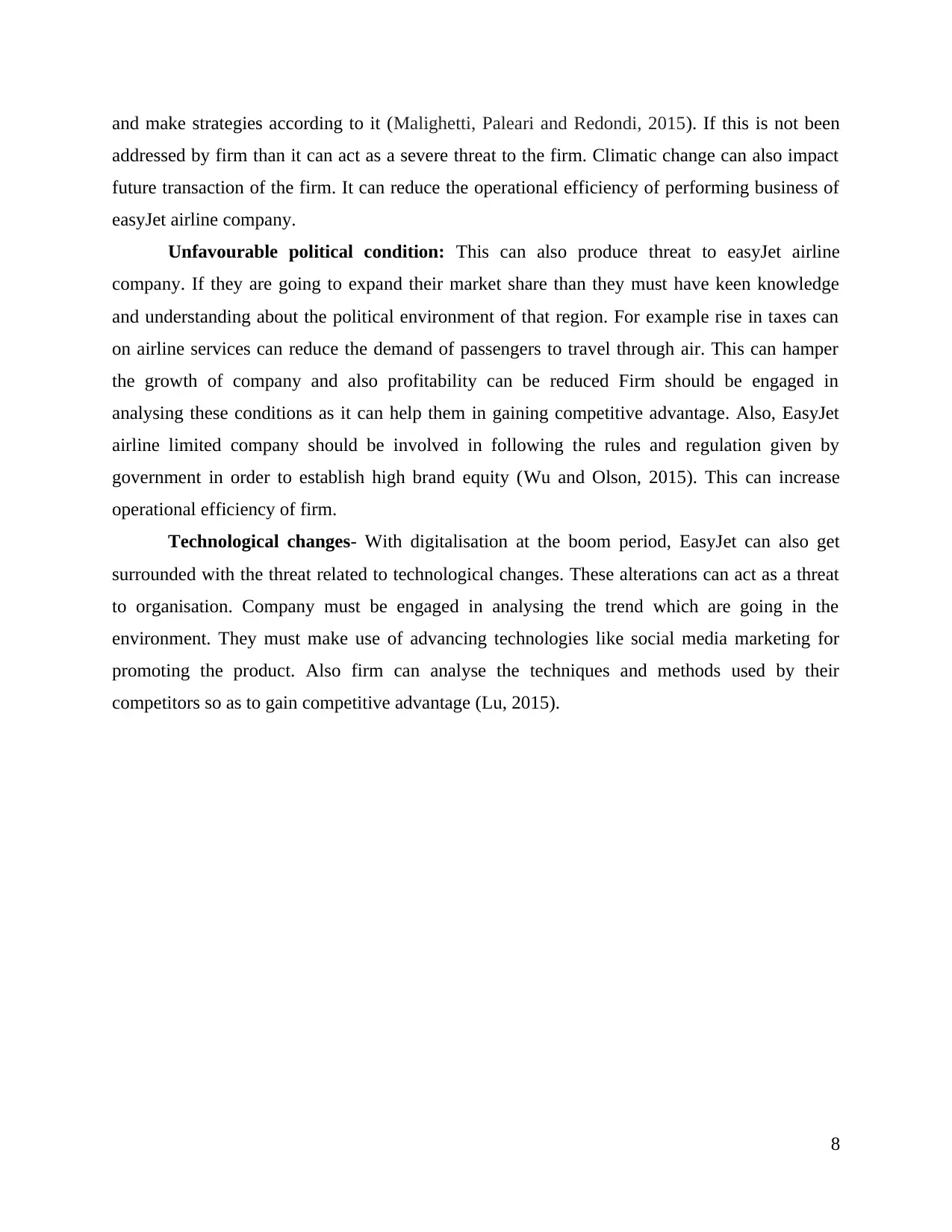
and make strategies according to it (Malighetti, Paleari and Redondi, 2015). If this is not been
addressed by firm than it can act as a severe threat to the firm. Climatic change can also impact
future transaction of the firm. It can reduce the operational efficiency of performing business of
easyJet airline company.
Unfavourable political condition: This can also produce threat to easyJet airline
company. If they are going to expand their market share than they must have keen knowledge
and understanding about the political environment of that region. For example rise in taxes can
on airline services can reduce the demand of passengers to travel through air. This can hamper
the growth of company and also profitability can be reduced Firm should be engaged in
analysing these conditions as it can help them in gaining competitive advantage. Also, EasyJet
airline limited company should be involved in following the rules and regulation given by
government in order to establish high brand equity (Wu and Olson, 2015). This can increase
operational efficiency of firm.
Technological changes- With digitalisation at the boom period, EasyJet can also get
surrounded with the threat related to technological changes. These alterations can act as a threat
to organisation. Company must be engaged in analysing the trend which are going in the
environment. They must make use of advancing technologies like social media marketing for
promoting the product. Also firm can analyse the techniques and methods used by their
competitors so as to gain competitive advantage (Lu, 2015).
8
addressed by firm than it can act as a severe threat to the firm. Climatic change can also impact
future transaction of the firm. It can reduce the operational efficiency of performing business of
easyJet airline company.
Unfavourable political condition: This can also produce threat to easyJet airline
company. If they are going to expand their market share than they must have keen knowledge
and understanding about the political environment of that region. For example rise in taxes can
on airline services can reduce the demand of passengers to travel through air. This can hamper
the growth of company and also profitability can be reduced Firm should be engaged in
analysing these conditions as it can help them in gaining competitive advantage. Also, EasyJet
airline limited company should be involved in following the rules and regulation given by
government in order to establish high brand equity (Wu and Olson, 2015). This can increase
operational efficiency of firm.
Technological changes- With digitalisation at the boom period, EasyJet can also get
surrounded with the threat related to technological changes. These alterations can act as a threat
to organisation. Company must be engaged in analysing the trend which are going in the
environment. They must make use of advancing technologies like social media marketing for
promoting the product. Also firm can analyse the techniques and methods used by their
competitors so as to gain competitive advantage (Lu, 2015).
8
Paraphrase This Document
Need a fresh take? Get an instant paraphrase of this document with our AI Paraphraser
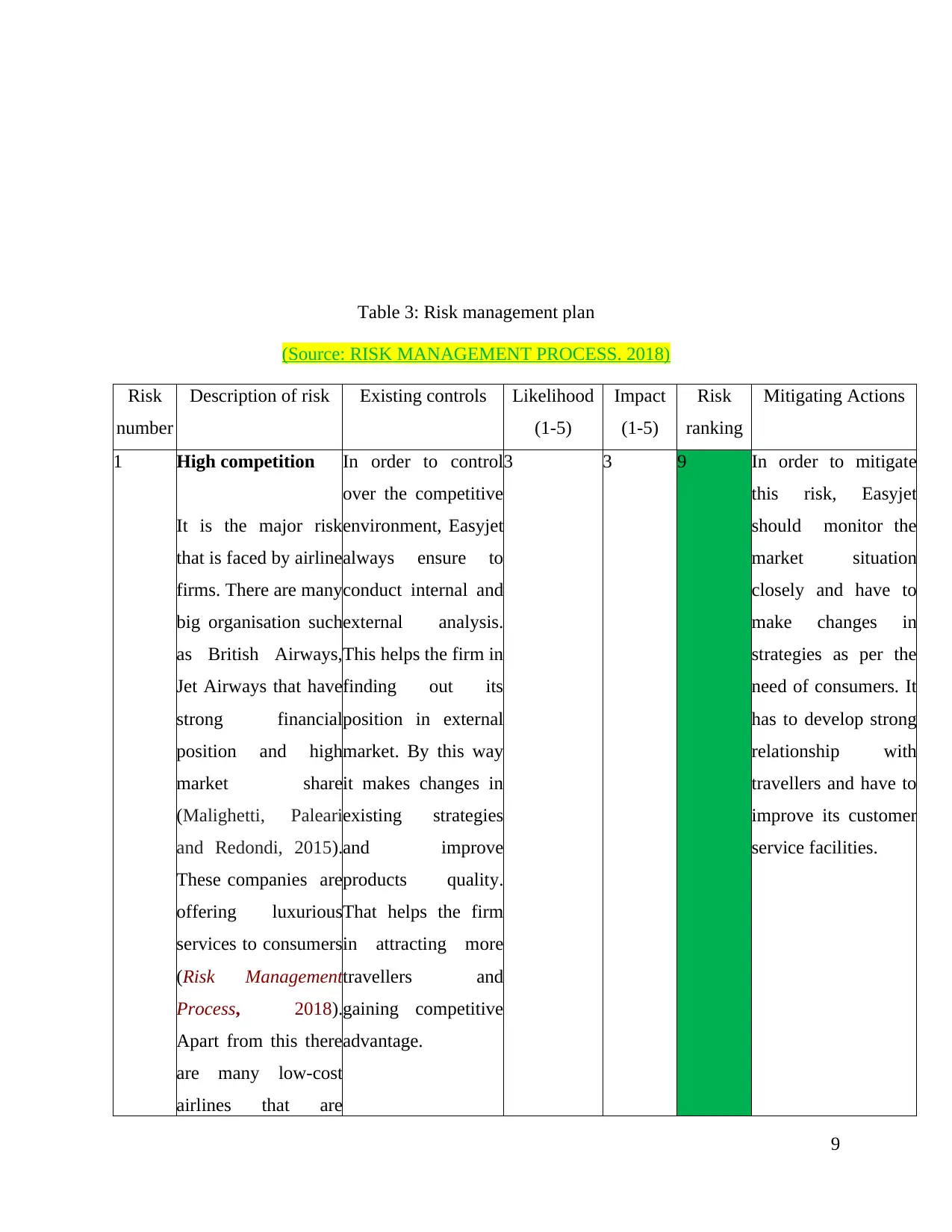
Table 3: Risk management plan
(Source: RISK MANAGEMENT PROCESS. 2018)
Risk
number
Description of risk Existing controls Likelihood
(1-5)
Impact
(1-5)
Risk
ranking
Mitigating Actions
1 High competition
It is the major risk
that is faced by airline
firms. There are many
big organisation such
as British Airways,
Jet Airways that have
strong financial
position and high
market share
(Malighetti, Paleari
and Redondi, 2015).
These companies are
offering luxurious
services to consumers
(Risk Management
Process, 2018).
Apart from this there
are many low-cost
airlines that are
In order to control
over the competitive
environment, Easyjet
always ensure to
conduct internal and
external analysis.
This helps the firm in
finding out its
position in external
market. By this way
it makes changes in
existing strategies
and improve
products quality.
That helps the firm
in attracting more
travellers and
gaining competitive
advantage.
3 3 9 In order to mitigate
this risk, Easyjet
should monitor the
market situation
closely and have to
make changes in
strategies as per the
need of consumers. It
has to develop strong
relationship with
travellers and have to
improve its customer
service facilities.
9
(Source: RISK MANAGEMENT PROCESS. 2018)
Risk
number
Description of risk Existing controls Likelihood
(1-5)
Impact
(1-5)
Risk
ranking
Mitigating Actions
1 High competition
It is the major risk
that is faced by airline
firms. There are many
big organisation such
as British Airways,
Jet Airways that have
strong financial
position and high
market share
(Malighetti, Paleari
and Redondi, 2015).
These companies are
offering luxurious
services to consumers
(Risk Management
Process, 2018).
Apart from this there
are many low-cost
airlines that are
In order to control
over the competitive
environment, Easyjet
always ensure to
conduct internal and
external analysis.
This helps the firm in
finding out its
position in external
market. By this way
it makes changes in
existing strategies
and improve
products quality.
That helps the firm
in attracting more
travellers and
gaining competitive
advantage.
3 3 9 In order to mitigate
this risk, Easyjet
should monitor the
market situation
closely and have to
make changes in
strategies as per the
need of consumers. It
has to develop strong
relationship with
travellers and have to
improve its customer
service facilities.
9
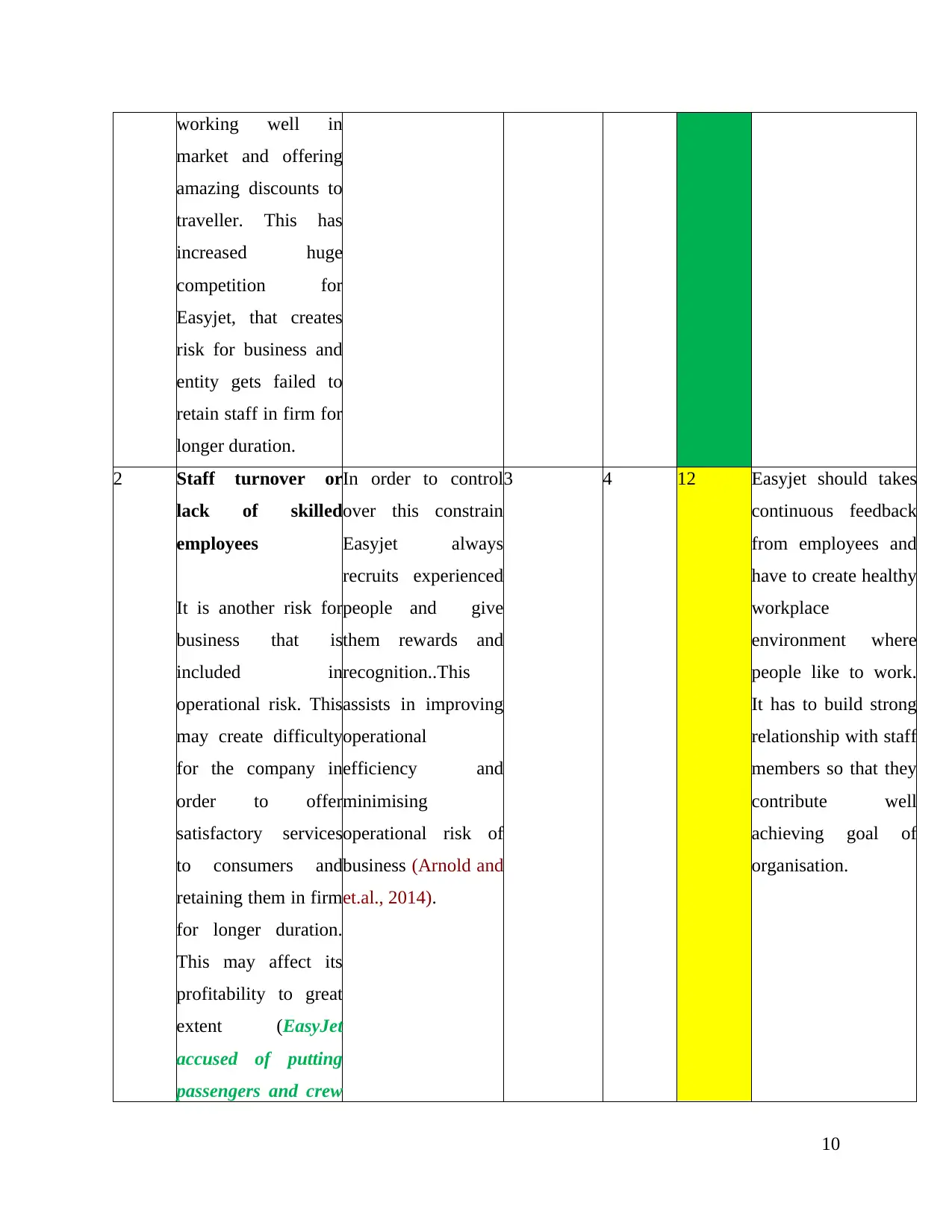
working well in
market and offering
amazing discounts to
traveller. This has
increased huge
competition for
Easyjet, that creates
risk for business and
entity gets failed to
retain staff in firm for
longer duration.
2 Staff turnover or
lack of skilled
employees
It is another risk for
business that is
included in
operational risk. This
may create difficulty
for the company in
order to offer
satisfactory services
to consumers and
retaining them in firm
for longer duration.
This may affect its
profitability to great
extent (EasyJet
accused of putting
passengers and crew
In order to control
over this constrain
Easyjet always
recruits experienced
people and give
them rewards and
recognition..This
assists in improving
operational
efficiency and
minimising
operational risk of
business (Arnold and
et.al., 2014).
3 4 12 Easyjet should takes
continuous feedback
from employees and
have to create healthy
workplace
environment where
people like to work.
It has to build strong
relationship with staff
members so that they
contribute well
achieving goal of
organisation.
10
market and offering
amazing discounts to
traveller. This has
increased huge
competition for
Easyjet, that creates
risk for business and
entity gets failed to
retain staff in firm for
longer duration.
2 Staff turnover or
lack of skilled
employees
It is another risk for
business that is
included in
operational risk. This
may create difficulty
for the company in
order to offer
satisfactory services
to consumers and
retaining them in firm
for longer duration.
This may affect its
profitability to great
extent (EasyJet
accused of putting
passengers and crew
In order to control
over this constrain
Easyjet always
recruits experienced
people and give
them rewards and
recognition..This
assists in improving
operational
efficiency and
minimising
operational risk of
business (Arnold and
et.al., 2014).
3 4 12 Easyjet should takes
continuous feedback
from employees and
have to create healthy
workplace
environment where
people like to work.
It has to build strong
relationship with staff
members so that they
contribute well
achieving goal of
organisation.
10
⊘ This is a preview!⊘
Do you want full access?
Subscribe today to unlock all pages.

Trusted by 1+ million students worldwide
1 out of 20
Related Documents
Your All-in-One AI-Powered Toolkit for Academic Success.
+13062052269
info@desklib.com
Available 24*7 on WhatsApp / Email
![[object Object]](/_next/static/media/star-bottom.7253800d.svg)
Unlock your academic potential
Copyright © 2020–2025 A2Z Services. All Rights Reserved. Developed and managed by ZUCOL.





